Imaging: Venus, Jupiter, Saturn, M57 Ring Nebula, Scorpius,
Lots of DSO Observing
Posted: 13 June 2015
|
Open: Friday, 12 June 2015, 1823 MST Temperature: 101°F |
Session: 834 Conditions: Clear |
1830 MST: viewed Venus, 83X. Then began setting up for imaging Venus. Mounted the D7200 DSLR at prime focus + 2X PowerMate. This is how Venus looked on the DSLR Live View screen (zoomed in):
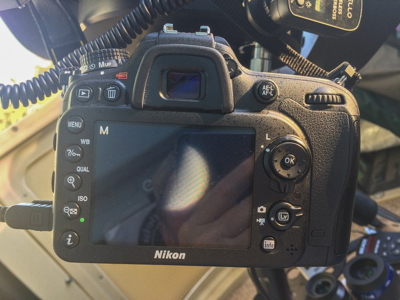
This is a stack of 942 HD video frames (Keith's Image Stacker), 1.3X crop factor, 60 fps, 1/500sec, ISO 400, 15 seconds:
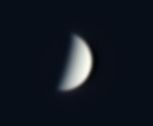
1848 MST: removed the camera from the 8" LX200-ACF and resumed Venus observing, 166X. Nice view.
1856 MST: viewed Jupiter, 166X. No moons yet visible against the bright sky. 1919 MST: three moons were now visible: Ganymede, Europa, and Io. 1924 MST: surprisingly good view of Jupiter, 166X. 1926 MST: Venus was an easy naked eye object in the sky; Jupiter was not visible. 1932 MST: Callisto became visible, 166X. 1934 MST: Jupiter now naked eye visible. 1935 MST: sunset.
1939 MST: remounted the DSLR at prime focus + 2X PowerMate. This is a stack of 936 HD video frames, 1.3X crop, 60 fps, 1/160sec, ISO 1600, 15 seconds:
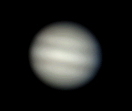
1945 MST: resumed Jupiter observing, 222X. 1956 MST: seeing at Jupiter rapidly deteriorated. Slewed to Saturn, which presented a nice view at 222X. Titan was the only moon visible against the still bright sky. 2000 MST: the moons Dione, Tethys, and Rhea were now visible at 222X. 2014 MST: terminated the first Kissing Bug seen this night. 2040 MST: seeing at Saturn was worsening. Switched to 83X.
2100 MST: started a "Tonight's Best" AutoStar Guided Tour using 83X. The following DSOs were observed: Albireo (double star), M13 (Hercules Globular Cluster), M44 (Praesepe open cluster), [terminated 2nd Kissing Bug], M4 (globular cluster), M27 (Dumbbell Nebula), M92 (globular cluster), M82 (Cigar Galaxy), M5 (globular cluster), M104 (Sombrero Galaxy), M57 (Ring Nebula), M68 (globular cluster), Centaurus A (galaxy), M52 (open cluster), M51 (Whirlpool Galaxy), and NGC 3115 (Spindle Galaxy). Then viewed the Leo Triplet of Galaxies: M65, M66, and NGC3628.
2142 MST: began preparing to image Saturn. Mounted the D7200 DSLR at prime focus + 2X PowerMate and did a focus test on the star Spica using a Bahtinov Mask. This is a stack of 936 HD video frames, 1.3X, 60 fps, 1/250sec, ISO 10000, 15 seconds:

(Both the Jupiter and Saturn HD video recordings were slightly underexposed. Really needed to use a slower shutter speed.)
2209 MST: began imaging M57 (Ring Nebula) at prime focus + 2X PowerMate using unguided 30 second and 1 minute exposures. This is 1 minute, ISO 6400:
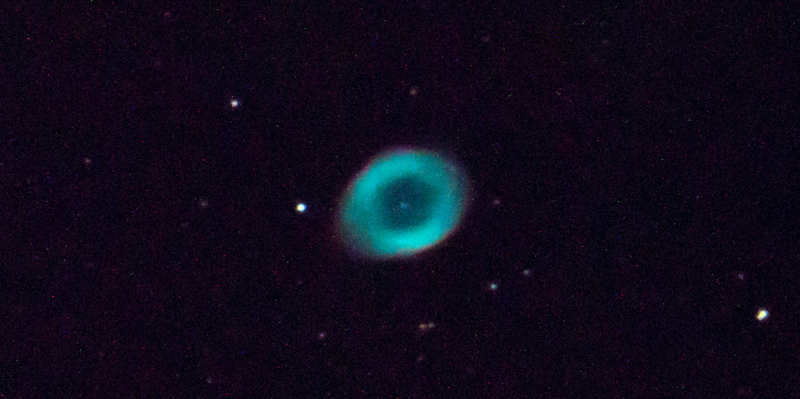
2232 MST: took this handheld iPhone 5s photo of the constellation of Scorpius and Saturn using NightCap Pro (Light Boost, 1/2sec, ISO 4000):
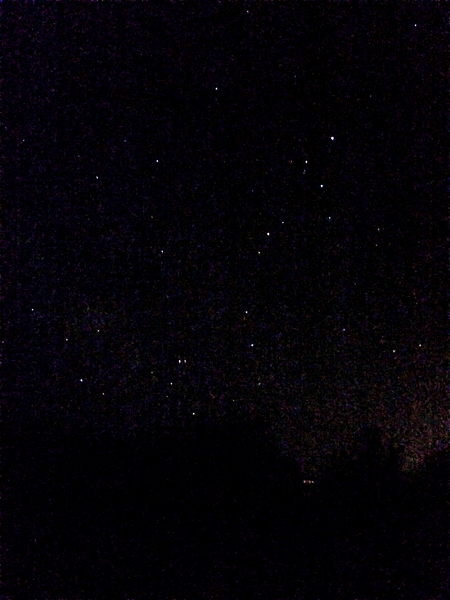
Mouseover or tap on image to see labels
2239 MST: it was getting breezy. Viewed Saturn, 166X and 83X. Seeing was not very good. Began closing up.
|
Close: Friday, 12 June 2015, 2251 MST Temperature: 75°F |
|
Comments are welcome using Email. If you are on Twitter you can use the button below to tweet this report to your followers. Thanks.
Cassiopeia Observatory Home Page
Copyright ©2015 Michael L. Weasner / mweasner@me.com
URL = http://www.weasner.com/co/Reports/2015/06/13/index.html
